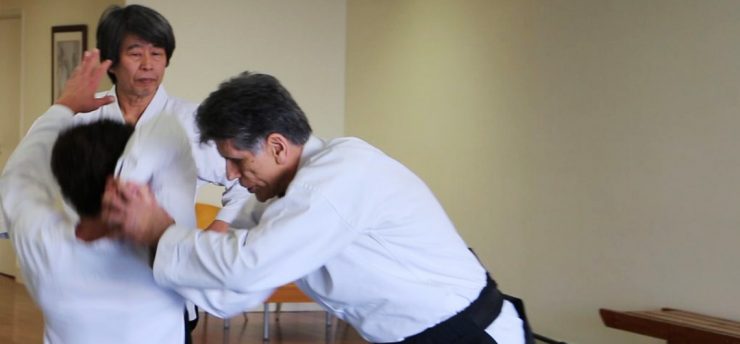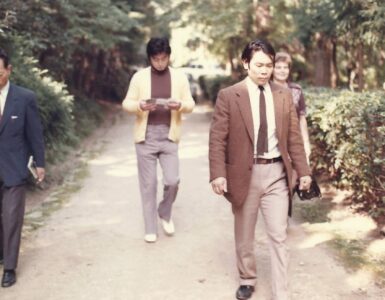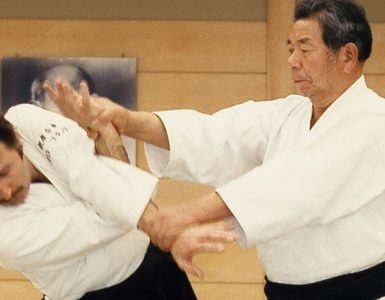In this fourth and final part of the series, we end our story on the move to a bilingual publication, traveling with Morihiro Saito, and the future of Aiki News. Read the third part here.
Changeover to a bilingual publication
 A few months after my arrival in Japan I found myself faced with a dilemma. Aiki News had started as an English-language newsletter during my California days, but now I was residing in the birthplace of aikido itself. Virtually all of the materials I was gathering and interviews I was conducting were in Japanese. It seemed a pity to offer the results of my research only in English since the Japanese themselves had few sources of such information. Without realizing the full implications of my decision, I set out to produce a bilingual publication. The first major task was to find a way to type the Japanese text. After much debate, I decided to purchase a used Japanese typewriter and tackled the difficult task of figuring out how the contraption worked. I was overwhelmed by this huge, unwieldy machine with its maze of thousands of lead kanji laid out in “iroha” order. Somehow I managed to type the entire text of both languages of the first Japanese-English issue which appeared in the summer of 1978.
A few months after my arrival in Japan I found myself faced with a dilemma. Aiki News had started as an English-language newsletter during my California days, but now I was residing in the birthplace of aikido itself. Virtually all of the materials I was gathering and interviews I was conducting were in Japanese. It seemed a pity to offer the results of my research only in English since the Japanese themselves had few sources of such information. Without realizing the full implications of my decision, I set out to produce a bilingual publication. The first major task was to find a way to type the Japanese text. After much debate, I decided to purchase a used Japanese typewriter and tackled the difficult task of figuring out how the contraption worked. I was overwhelmed by this huge, unwieldy machine with its maze of thousands of lead kanji laid out in “iroha” order. Somehow I managed to type the entire text of both languages of the first Japanese-English issue which appeared in the summer of 1978.
One of the most pressing tasks called for in order to document aikido history was to systematically interview the art’s oldtimers, specifically those who trained under the founder, Morihei Ueshiba, prior to World War II. Since all of these people were quite aged, I felt a continuing sense of urgency about getting the job done. My Japanese language skills in those days were fairly limited and in the early years of my stay in Japan I was assisted by my translator and Japanese editor, Midori Yamamoto. Through interviews of such people as Shigemi Yonekawa, Hisao Kamata, Zenzaburo Akazawa, Kenji Tomiki, Rinjiro Shirata, Gozo Shioda, Tenryu as well as Doshu Kisshomaru Ueshiba, the fascinating story of the birth of aikido began to reveal itself. Along the way, we discovered a copy of the old Asahi News film of Ueshiba made in 1935 and the rare technical manual entitled Budo he published in 1938. These invaluable documents had of course always existed, but until then were virtually unknown to the aikido community. Little by little our collection of materials on aikido increased to respectable proportions and Aiki News was the major vehicle for the dissemination of our findings.
Although the publication was a very time-consuming endeavor, still it remained a hobby for me for the next several years when I first supported myself as a language teacher, and later as a technical translator. After having lived for some four-and-a-half years in Iwama and training under Morihiro Saito Sensei, I moved to Tokyo in 1982. Shortly thereafter, I was joined by our present Japanese editor Ikuko Kimura whose presence resulted in an immediate improvement in the quality of Aiki News and strengthened our commitment to its publication
Friendship Demonstrations
In the later part of 1984, I had the idea of sponsoring a special kind of aikido demonstration. Up until that time the exhibitions held tended to be intra-organizational affairs. Those that took place annually were very similar in content year after year. They were ideal for members of the sponsoring organizations, but were not well-attended by the general public. I wanted to attempt something different and conceived of a new educational format where leading teachers from any organization could share the stage and give in-depth lecture demonstrations. In addition to providing the audience with a particularly intense and stimulating experience, this approach would afford the participating teachers with a rare opportunity to meet with their peers and exchange views. Although everyone seemed to laud the concept of such a demonstration, some teachers were reluctant to actually participate and gathering together the first group of top teachers proved to be a formidable diplomatic task. Persistence won out in the end and the first Aiki News Friendship Demonstration was held in April 1985 “in commemoration of Morihei Ueshiba.” It featured six well-known aikido teachers and was attended by some 900 persons. Aiki News would organize three more Friendship Demonstrations each year through 1988 which introduced various themes designed to shed light on the technical influences on aikido and its major modern interpretations.
Traveling abroad with Morihiro Saito Sensei
In the mid-1980s I had the opportunity to accompany Morihiro Saito Sensei on overseas trips to the USA and some six European countries as his interpreter. These experiences were memorable for me since they afforded many occasions for in-depth talks with one of the acknowledged technical masters of our times. During the many hours in airports, on planes, and free time at seminars our talks covered a wide range of topics including Saito Sensei’s early days of training under the founder and his theories on teaching. These trips also provided an ideal vehicle for exposing large audiences to Aiki News and Saito Sensei was very cooperative in this regard. Moreover, on the five or six occasions when we visited Italy, we completed five instructional videotapes with the assistance of one of Saito Sensei’s leading students, Dr. Paolo Corallini. These tapes, in particular, the two on the aiki ken and jo have been very well received the world over. These trips also afforded me a chance to familiarize myself with the myriad of aikido organizations in the USA and Europe.
One of the most pressing tasks called for in order to document aikido history was to systematically interview the art’s oldtimers, specifically those who trained under the founder, Morihei Ueshiba, prior to World War II. Since all of these people were quite aged, I felt a continuing sense of urgency about getting the job done. My Japanese language skills in those days were fairly limited and in the early years of my stay in Japan I was assisted by my translator and Japanese editor, Midori Yamamoto. Through interviews of such people as Shigemi Yonekawa, Hisao Kamata, Zenzaburo Akazawa, Kenji Tomiki, Rinjiro Shirata, Gozo Shioda, Tenryu as well as Doshu Kisshomaru Ueshiba, the fascinating story of the birth of aikido began to reveal itself.
Daito-ryu connection
Given our focus on aikido history, we were exposed over the years to testimonies by early students of the founder regarding the role of Daito-ryu Aikijujutsu and his controversial teacher Sokaku Takeda on the development of aikido. At first, I found myself captive to preconceptions about Daito-ryu and Takeda common in aikido circles. Daito-ryu was a violent jujutsu form disseminated by the ill-tempered, eccentric Sokaku who also happened to be a technical genius. Its influence on aikido was significant, but Morihei Ueshiba had improved upon the art, eliminated the dangerous techniques, and infused it with an ethical core. In retrospect, this view is correct as far as it goes. However, it fails to appreciate the technical range and sophistication of Daito-ryu techniques and minimizes the primordial role of Takeda as the most important disseminator of jujutsu techniques in 20th century Japan.
Belatedly, in 1985, we set out for Hokkaido where we began the first of a series of interviews with Tokimune Takeda, the son of Sokaku, and present soke of Daito-ryu Aikijujutsu. This was to prove an eye-opening experience for Aiki News as we started to realize the many ways that the destinies of Ueshiba and Takeda were intertwined on a personal and professional level. The founder of aikido taught Daito-ryu as a certified instructor (kyoju dairi) for some 15 years and awarded certificates as Takeda’s representative. The history of Daito-ryu is long and rich, and from its perspective, the development of aikido constitutes one of several branches. The art is also the most vigorous of Japan’s few surviving jujutsu schools and must be considered a cultural treasure in its own right. Moreover, as a result of our research into Daito-ryu, I acquired many new acquaintances in that world. In the personal and professional regard, my association with Soke Kyoju Dairi Katsuyuki Kondo has proven to be a wonderful asset. Kondo Sensei’s perspectives on Daito-ryu based on more than 30 years of training and his familiarity with aikido and its history have enabled me to appreciate the Daito-ryu legacy in a new light. There is no doubt in my mind that despite attempts to the contrary by individuals on both sides to distance the two arts, aikido and Daito-ryu Aikijujutsu will be recorded as kindred arts in the annals of martial arts history.
One of the most challenging aspects of publishing a specialized magazine such as Aiki News has been attempting to provide high quality, substantive content while achieving a commercial success. Not that these goals are mutually exclusive, but it has been an upward struggle to realize this end due to the limited number of aikido practitioners in Japan. Our personal estimate is that there are some 25,000 to 40,000 active students of the art at the present time. Of course, many more have practiced the art at one time or other, but the prospective readership falls short of the several hundreds of thousands which support other specialized publications. Faced with this situation, we have recently placed an emphasis on book publication. Books tend to reach a much wider audience, remain on the book shelves for long periods and, if successful, can be reprinted many times. Our first successful offering was Ueshiba Morihei to Aikido, which appeared in April 1990. It will enter its second printing in the spring of this year and plans are underway for a new Japanese-language book to appear later in the year. On the English side, we published the The Aiki News Encyclopedia of Aikido this fall in America. This work contains some 800 biographical entries and more than 350 photos and so far we have been pleased by its enthusiastic reception. A French and possibly a Japanese edition are currently under consideration. We are also translating into English the best selling Zen and Aikido written by Shimizu Kenji and Kamata Shigeo.
Future directions
It is hard to predict what the future will hold for Aiki News. There are many projects to be undertaken of a historical nature and someday I would like to write a biography of Morihei Ueshiba. Moreover, there is much work to be done in finding specific, social applications for aikido philosophy in a technologically sophisticated world peopled by adults whose methods for dealing with conflict show no advance over those employed by primitive tribes.
Given our focus on aikido history, we were exposed over the years to testimonies by early students of the founder regarding the role of Daito-ryu Aikijujutsu and his controversial teacher Sokaku Takeda on the development of aikido. At first, I found myself captive to preconceptions about Daito-ryu and Takeda common in aikido circles. Daito-ryu was a violent jujutsu form disseminated by the ill-tempered, eccentric Sokaku who also happened to be a technical genius. Its influence on aikido was significant, but Morihei Ueshiba had improved upon the art, eliminated the dangerous techniques, and infused it with an ethical core. In retrospect, this view is correct as far as it goes. However, it fails to appreciate the technical range and sophistication of Daito-ryu techniques and minimizes the primordial role of Takeda as the most important disseminator of jujutsu techniques in 20th century Japan.
In closing, I would like to thank the editors of Wushu magazine for allowing me the chance to share with readers my experiences and views about the arts of aikido and Daito-ryu. I hope that the perspectives of a foreigner in the martial arts world of Japan will cause Japanese readers to reflect on the great value of these arts as cultural assets and realize that Japan’s current international status does not rest exclusively on its financial clout or the export of high-quality manufactured goods.
This article is the final installment of a four-part series of autobiographical articles by Aiki News Editor-in-chief Stanley Pranin and was first published in 1990 in Wushu, a Japanese-language magazine dealing with Chinese martial arts. Read the first part here.













Time for an update to bring us up to date from 1990 to 2013 ?
🙂
Thank you, Josh, for making this available again. This last installment is a prime example of his modesty as to his own contribution to Aikido, presenting instead the big picture true to the historian that he was. Two instances might illuminate that point:
In the 1980s Stan was heavily involved in Iwama Aikido. When he discovered the 1938 technical manual by O Sensei, he brought it to Iwama and Saito Sensei was overjoyed as it showed the techniques exactly as he used to present them, thus being proof to his claim to only teach exactly what he learned from O Sensei. He used it henceforth in his seminars to underline that point.
Shortly after the recording of the groundbreaking technical videos with Saito Sensei in Italy, Sensei kicked him out of the dojo because of a dispute about money. Stan was deeply hurt by this. It clearly shows Stan’s generosity and loyalty that he does not even mention that fact in his memoires.